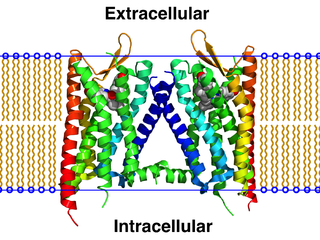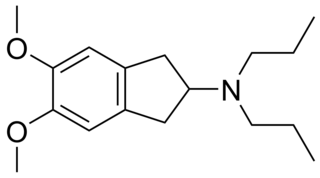Classical conditioning is a behavioral procedure in which a biologically potent stimulus is paired with a neutral stimulus. The term classical conditioning refers to the process of an automatic, conditioned response that is paired with a specific stimulus.
Dynorphins (Dyn) are a class of opioid peptides that arise from the precursor protein prodynorphin. When prodynorphin is cleaved during processing by proprotein convertase 2 (PC2), multiple active peptides are released: dynorphin A, dynorphin B, and α/β-neoendorphin. Depolarization of a neuron containing prodynorphin stimulates PC2 processing, which occurs within synaptic vesicles in the presynaptic terminal. Occasionally, prodynorphin is not fully processed, leading to the release of “big dynorphin.” “Big Dynorphin” is a 32-amino acid molecule consisting of both dynorphin A and dynorphin B.
In internal medicine, relapse or recidivism is a recurrence of a past condition. For example, multiple sclerosis and malaria often exhibit peaks of activity and sometimes very long periods of dormancy, followed by relapse or recrudescence.
Conditioned taste aversion occurs when an animal acquires an aversion to the taste of a food that was paired with aversive stimuli. The Garcia effect explains that the aversion develops more strongly for stimuli that cause nausea than other stimuli. This is considered an adaptive trait or survival mechanism that enables the organism to avoid poisonous substances before they cause harm. The aversion reduces consuming the same substance in the future, thus avoiding poisoning.
Extinction is a behavioral phenomenon observed in both operantly conditioned and classically conditioned behavior, which manifests itself by fading of non-reinforced conditioned response over time. When operant behavior that has been previously reinforced no longer produces reinforcing consequences the behavior gradually stops occurring. In classical conditioning, when a conditioned stimulus is presented alone, so that it no longer predicts the coming of the unconditioned stimulus, conditioned responding gradually stops. For example, after Pavlov's dog was conditioned to salivate at the sound of a metronome, it eventually stopped salivating to the metronome after the metronome had been sounded repeatedly but no food came. Many anxiety disorders such as post traumatic stress disorder are believed to reflect, at least in part, a failure to extinguish conditioned fear.

An avoidance response is a response that prevents an aversive stimulus from occurring. It is a kind of negative reinforcement. An avoidance response is a behavior based on the concept that animals will avoid performing behaviors that result in an aversive outcome. This can involve learning through operant conditioning when it is used as a training technique. It is a reaction to undesirable sensations or feedback that leads to avoiding the behavior that is followed by this unpleasant or fear-inducing stimulus.

The κ-opioid receptor or kappa opioid receptor, abbreviated KOR or KOP for its ligand ketazocine, is a G protein-coupled receptor that in humans is encoded by the OPRK1 gene. The KOR is coupled to the G protein Gi/G0 and is one of four related receptors that bind opioid-like compounds in the brain and are responsible for mediating the effects of these compounds. These effects include altering nociception, consciousness, motor control, and mood. Dysregulation of this receptor system has been implicated in alcohol and drug addiction.
Cue reactivity is a type of learned response which is observed in individuals with an addiction and involves significant physiological and psychological reactions to presentations of drug-related stimuli. The central tenet of cue reactivity is that cues previously predicting receipt of drug reward under certain conditions can evoke stimulus associated responses such as urges to use drugs. In other words, learned cues can signal drug reward, in that cues previously associated with drug use can elicit cue-reactivity such as arousal, anticipation, and changes in behavioral motivation. Responses to a drug cue can be physiological, behavioral, or symbolic expressive. The clinical utility of cue reactivity is based on the conceptualization that drug cues elicit craving which is a critical factor in the maintenance and relapse to drug use. Additionally, cue reactivity allows for the development of testable hypotheses grounded in established theories of human behavior. Therefore, researchers have leveraged the cue reactivity paradigm to study addiction, antecedents of relapse, craving, translate pre-clinical findings to clinical samples, and contribute to the development of new treatment methods. Testing cue reactivity in human samples involves exposing individuals with a substance use disorder to drug-related cues and drug neutral cues, and then measuring their reactions by assessing changes in self-reported drug craving and physiological responses.

The reward system is a group of neural structures responsible for incentive salience, associative learning, and positively-valenced emotions, particularly ones involving pleasure as a core component. Reward is the attractive and motivational property of a stimulus that induces appetitive behavior, also known as approach behavior, and consummatory behavior. A rewarding stimulus has been described as "any stimulus, object, event, activity, or situation that has the potential to make us approach and consume it is by definition a reward". In operant conditioning, rewarding stimuli function as positive reinforcers; however, the converse statement also holds true: positive reinforcers are rewarding.

SB-277,011A is a drug which acts as a potent and selective dopamine D3 receptor antagonist, which is around 80-100x selective for D3 over D2, and lacks any partial agonist activity.

Ro64-6198 is an opioid drug used in scientific research. It acts as a potent and selective agonist for the nociceptin receptor, also known as the ORL-1 receptor, with over 100x selectivity over the other opioid receptors. It produces anxiolytic effects in animal studies equivalent to those of benzodiazepine drugs, but has no anticonvulsant effects and does not produce any overt effects on behaviour. However it does impair short-term memory, and counteracts stress-induced anorexia. It also has antitussive effects, and reduces the rewarding and analgesic effects of morphine, although it did not prevent the development of dependence. It has been shown to reduce alcohol self-administration in animals and suppressed relapses in animal models of alcoholism, and ORL-1 agonists may have application in the treatment of alcoholism.

2-Methyl-6-(phenylethynyl)pyridine (MPEP) is a research drug which was one of the first compounds found to act as a selective antagonist for the metabotropic glutamate receptor subtype mGluR5. After being originally patented as a liquid crystal for LCDs, it was developed by the pharmaceutical company Novartis in the late 1990s. It was found to produce neuroprotective effects following acute brain injury in animal studies, although it was unclear whether these results were purely from mGluR5 blockade as it also acts as a weak NMDA antagonist, and as a positive allosteric modulator of another subtype mGlu4, and there is also evidence for a functional interaction between mGluR5 and NMDA receptors in the same populations of neurons. It was also shown to produce antidepressant and anxiolytic effects in animals, and to reduce the effects of morphine withdrawal, most likely due to direct interaction between mGluR5 and the μ-opioid receptor.

3-( ethynyl)pyridine (MTEP) is a research drug that was developed by Merck & Co. as a selective allosteric antagonist of the metabotropic glutamate receptor subtype mGluR5. Identified through structure-activity relationship studies on an older mGluR5 antagonist MPEP, MTEP has subsequently itself acted as a lead compound for newer and even more improved drugs.
Self-administration is, in its medical sense, the process of a subject administering a pharmacological substance to themself. A clinical example of this is the subcutaneous "self-injection" of insulin by a diabetic patient.

PNU-99,194(A) (or U-99,194(A)) is a drug which acts as a moderately selective D3 receptor antagonist with ~15-30-fold preference for D3 over the D2 subtype. Though it has substantially greater preference for D3 over D2, the latter receptor does still play some role in its effects, as evidenced by the fact that PNU-99,194 weakly stimulates both prolactin secretion and striatal dopamine synthesis, actions it does not share with the more selective (100-fold) D3 receptor antagonists S-14,297 and GR-103,691.

BP-897 is a drug used in scientific research which acts as a potent selective dopamine D3 receptor partial agonist with an in vitro intrinsic activity of ~0.6 and ~70x greater affinity for D3 over D2 receptors and is suspected to have partial agonist or antagonist activity in vivo. It has mainly been used in the study of treatments for cocaine addiction. A study comparing BP-897 with the potent, antagonistic, and highly D3 selective SB-277,011-A found, "SB 277011-A (1–10 mg/kg) was able to block cue-induced reinstatement of nicotine-seeking, indicating that DRD3 selective antagonism may be an effective approach to prevent relapse for nicotine. In contrast, BP 897 did not block the cue-induced reinstatement of nicotine-seeking or nicotine-taking under the FR5 schedule."
Animal models of depression are research tools used to investigate depression and action of antidepressants as a simulation to investigate the symptomatology and pathophysiology of depressive illness or used to screen novel antidepressants. These models provide insights into molecular, genetic, and epigenetic factors associated with depression. Criteria for valid animal models include face, construct, and predictive validity. Endophenotypes, such as anhedonia, behavioral despair, changes in appetite, neuroanatomical alterations, neuroendocrine disturbances, alterations in sleep architecture, and anxiety-related behaviors, are evaluated in these models. Antidepressant screening tests are employed to assess the effects of genetic, pharmacological, or environmental manipulations. Stress models, including learned helplessness, chronic mild stress, and social defeat stress, simulate the impact of stressors on depression. Early life stress models, psychostimulant withdrawal models, olfactory bulbectomy, and genetically engineered mice contribute to a comprehensive understanding of depression's etiology and potential therapeutic interventions.
Buprenorphine/naltrexone is an experimental combination drug formulation of buprenorphine, a μ-opioid receptor (MOR) weak partial agonist and κ-opioid receptor (KOR) antagonist, and naltrexone, a MOR and KOR silent antagonist, which is under investigation for the potential treatment of psychiatric disorders. The combination of the two drugs is thought to result in a selective blockade of the KOR and hence fewer MOR activation-related concerns such as euphoria and opioid dependence. It has been found to produce antidepressant-like effects in mice and has recently been found to be effective in the treatment of cocaine dependence in a large clinical trial.
Ream Al-Hasani is a British neuroscientist and pharmacologist as well as an assistant professor of anesthesiology at Washington University in St. Louis. Al-Hasani studies the endogenous opioid system to understand how to target it therapeutically to treat addiction, affective disorders, and chronic pain.
The neuronal acetylcholine receptor subunit alpha-5, or alpha-5 nicotinic acetylcholine receptor(α5 nAChR) also known as the α5 receptor is a type of ligand gated neuronal type subunit of the nicotinic acetylcholine receptor involved in pain regulation encoded in the human by the CHRNA5 gene. This receptor is commonly associated with nicotine addiction, immunotherapy, cancer, pain and attention.












